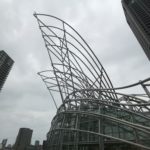Osaka
We had our morning espresso at Bogart’s, looking out on one of the canals and listening to recordings of familiar songs sung Hawaiian style, accompanied by a ukulele!
We spent the morning at the National Museum of Art, viewing an excellent exhibition, “The Myriad Forms of Visual Art”, comprising 196 works from the collection presented in 19 themes. In addition to many Japanese artists (almost all new to us), including Jiro Takamatsu, there were works by Moore, Warhol, Picasso, Ernst, Newman, Giacometti, and Lichtenstein (his “Water Lilies with Japanese Bridge” is wonderful), among others.
The afternoon was devoted to an introduction to Bunraku, a sophisticated form of traditional Japanese puppet theatre founded in Osaka in the beginning of 17th century. Bunraku, like Kabuki, often depict stories based on adaptations of scripts with similar themes. Classic tragic love stories, heroic legends and tales based on historical events are popular. The show at the National Bunraku Theatre was billed as a performance for beginners and included an introduction to the almost life-size puppets and the work of the puppeteers. All but the most minor characters require three puppeteers, who perform in full view of the audience, generally wearing black robes. In the National Bunraku Theatre, the main puppeteer, omozukai, is unhooded. Bunraku synchronizes narrative recitation, shamisen music and puppetry in performance. The chanter or “Tayu” and the shamisen player are off to one side. The Tayu chants and sings the story and also voices the puppet characters, changing his speech and intonation to express different genders, ages, and social ranking. The theatre had a revolving platform for the chanter and shamisen player, which rotated bringing replacement musicians for the next scene.
We had been informed that there would be no English audio guide, but the program précis helped enough for us to get a sense of the proceedings. The main performance dramatized an incident in the late 16th century in which the samurai and general Akechi Mitsuhide overthrew his lord, Oda Nobunaga, and then is himself struck down. The performances were incredible and the ranges of emotion expressed, astounding. The shamisen player complemented the narrator precisely. Surprisingly, you get pulled into the performance on stage and almost forget about the chanter.
In Osaka, regular performances in July and August start at 11am and are in three parts ending around 8:40 pm!


